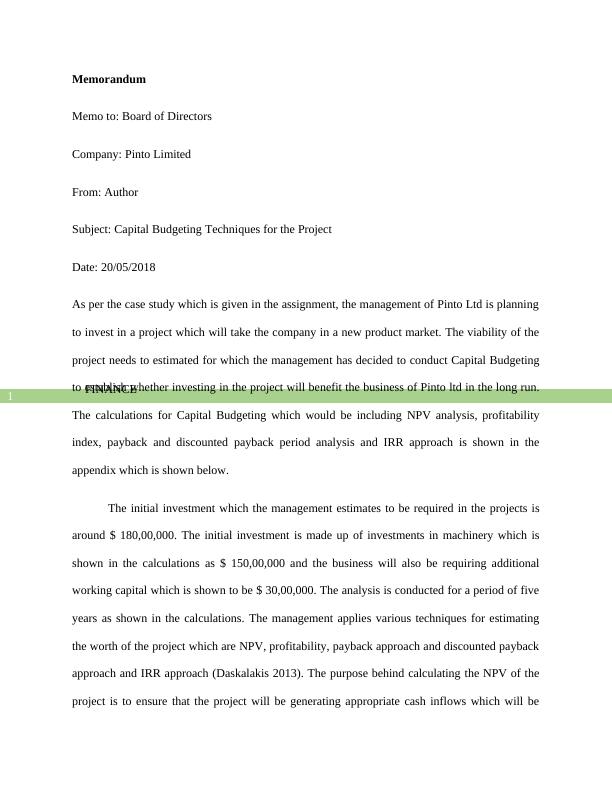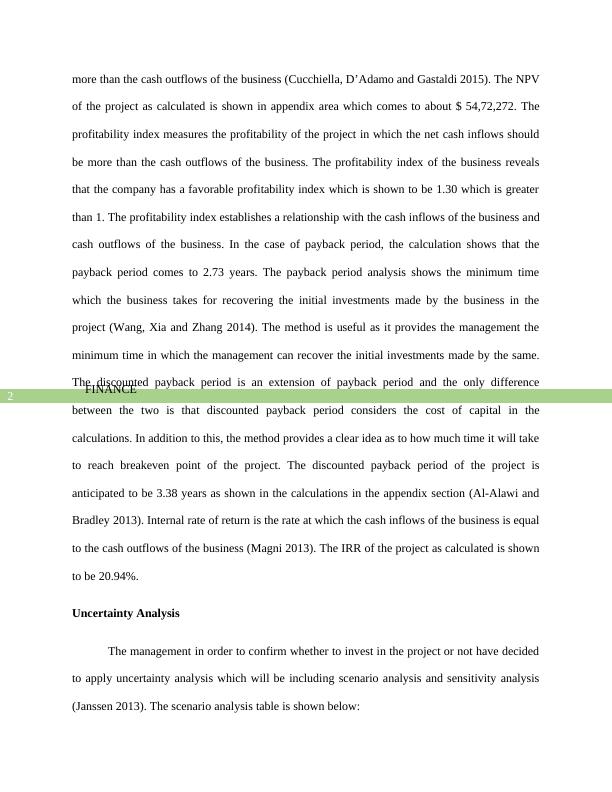Capital Budgeting Techniques - Doc
Added on 2021-05-31
7 Pages1424 Words115 Views
Running head: FINANCEFINANCEName of the Student:Name of the University:Author’s Note

FINANCE1MemorandumMemo to: Board of DirectorsCompany: Pinto LimitedFrom: AuthorSubject: Capital Budgeting Techniques for the ProjectDate: 20/05/2018As per the case study which is given in the assignment, the management of Pinto Ltd is planningto invest in a project which will take the company in a new product market. The viability of theproject needs to estimated for which the management has decided to conduct Capital Budgetingto establish whether investing in the project will benefit the business of Pinto ltd in the long run.The calculations for Capital Budgeting which would be including NPV analysis, profitabilityindex, payback and discounted payback period analysis and IRR approach is shown in theappendix which is shown below.The initial investment which the management estimates to be required in the projects isaround $ 180,00,000. The initial investment is made up of investments in machinery which isshown in the calculations as $ 150,00,000 and the business will also be requiring additionalworking capital which is shown to be $ 30,00,000. The analysis is conducted for a period of fiveyears as shown in the calculations. The management applies various techniques for estimatingthe worth of the project which are NPV, profitability, payback approach and discounted paybackapproach and IRR approach (Daskalakis 2013). The purpose behind calculating the NPV of theproject is to ensure that the project will be generating appropriate cash inflows which will be

FINANCE2more than the cash outflows of the business (Cucchiella, D’Adamo and Gastaldi 2015). The NPVof the project as calculated is shown in appendix area which comes to about $ 54,72,272. Theprofitability index measures the profitability of the project in which the net cash inflows shouldbe more than the cash outflows of the business. The profitability index of the business revealsthat the company has a favorable profitability index which is shown to be 1.30 which is greaterthan 1. The profitability index establishes a relationship with the cash inflows of the business andcash outflows of the business. In the case of payback period, the calculation shows that thepayback period comes to 2.73 years. The payback period analysis shows the minimum timewhich the business takes for recovering the initial investments made by the business in theproject (Wang, Xia and Zhang 2014). The method is useful as it provides the management theminimum time in which the management can recover the initial investments made by the same.The discounted payback period is an extension of payback period and the only differencebetween the two is that discounted payback period considers the cost of capital in thecalculations. In addition to this, the method provides a clear idea as to how much time it will taketo reach breakeven point of the project. The discounted payback period of the project isanticipated to be 3.38 years as shown in the calculations in the appendix section (Al-Alawi andBradley 2013). Internal rate of return is the rate at which the cash inflows of the business is equalto the cash outflows of the business (Magni 2013). The IRR of the project as calculated is shownto be 20.94%.Uncertainty AnalysisThe management in order to confirm whether to invest in the project or not have decidedto apply uncertainty analysis which will be including scenario analysis and sensitivity analysis(Janssen 2013). The scenario analysis table is shown below:

End of preview
Want to access all the pages? Upload your documents or become a member.
Related Documents
Finance Concepts (PDF)lg...
|10
|1525
|56
Capital Budgeting Techniques for the Project - Financelg...
|8
|1837
|213
Capital Budgeting Techniques for the Project - Pinto Limitedlg...
|8
|1508
|225
Significance of Proposed Project for Pinto Limited - Financial Viability Analysislg...
|7
|1144
|209
(PDF) Case Examples of Project Evaluationslg...
|6
|1278
|54
Evaluation of Financial Analysis - PDFlg...
|7
|1337
|32
